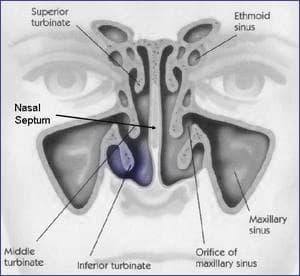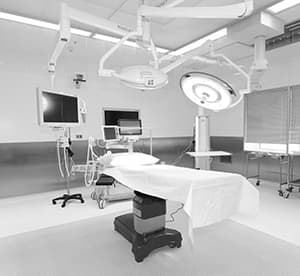Turbinoplasty Surgery In Dubai
Turbinectomy surgery in Dubai
If you’ve been struggling with chronic nasal congestion,breathing difficulties, or recurrent sinus infections, nasal turbinoplasty surgery ( Turbinectomy surgery in Dubai) might be the key to getting your right nose back.
This surgical procedure performed by Dr Levente Deak aims to address issues stemming from enlarged nasal turbinates, providing relief and improving nasal airflow.

Turbinoplasty Meaning
Turbinoplasty is a surgical procedure aimed at reducing the size of the turbinates in the nose to improve airflow.
Turbinates are like cushions on the side of the nose that contain bone and are covered with glandular tissue, which produces mucus. Sometimes, things like allergies, infections, or changes in temperature can make these turbinates swell up, blocking your nose.
If this blockage doesn’t go away and affects your daily life, you can talk to Dr Levente for nasal turbinoplasty surgery.
Before Your Turbinoplasty Surgery
Before the turbinoplasty surgery, it’s important to make some lifestyle changes to help ensure the best outcome.
Here’s what Dr Levente recommends:
- Stop smoking and cut down on alcohol as much as you can. Smoking and excessive alcohol can slow down healing and increase the risk of complications.
- Clean your nose daily by rinsing it with saline solution. This helps keep your nasal passages clear and reduces the risk of infection.
- If needed, continue using nasal steroid sprays as directed by your doctor. These can help reduce inflammation in your nasal passages.
- Avoid consuming certain foods and medications that may affect blood clotting for a minimum of two weeks before the surgery. These include aspirin, vitamin E, St. John's wort, Otrivine nasal spray, dietary supplements, NSAID pain relievers, garlic, and ginseng.

Following these recommendations can help prepare your body for surgery and promote a smoother recovery afterwards.
How is Turbinoplasty Performed?
The goal of the nasal turbinoplasty procedure is to trim the lower “side cushions” on the sidewall of the nose to improve nasal airflow and make it easier to breathe through the nose.
Before the turbinoplasty surgery, Dr Levente will assess the origins of the problem – bone or soft tissue to choose the best and least invasive method to get a quick and effective result.
You won’t need any nasal packing after the surgery. Nasal drops are recommended for a few days to maintain a clear nose.
The patient is usually discharged two hours after the turbinoplasty procedure. There won’t be any bruising around your eyes, no cuts on the outside of your nose, and the shape of your nose won’t change.
Recovery Post-Turbinoplasty Surgery
In the Hospital – First Six Hours
After the surgery, you might wake up with some packing inside your nose to prevent bleeding. It’s important to refrain from touching or removing this packing on your own. Dr Levente will take care of removing it when appropriate.
For the first week after surgery:
- Avoid blowing your nose to prevent any disturbance to the healing process.
- Don't hesitate to contact the nurse if you feel any discomfort or pain. Pain can usually be managed easily with regular painkillers.
The First Week at Home
After the surgery, you may notice some blood stains or pinkish discharge for a few days. This is normal and should decrease over time, but you might still see some spotting on your handkerchief for a few weeks afterwards.
Here’s what you should keep in mind during your recovery:
- Avoid moderate to heavy physical activity, including sports, for at least ten days after the operation. Also, avoid bending down to pick up heavy objects, as this could strain your nose.
- Wait at least two weeks before resuming active sports, and then gradually increase your activity level.
- It is normal for the nose to feel blocked for up to two weeks after the surgery as the swelling settles.
- Use the saline solution provided to irrigate your nose at least three times a day. This helps clear away scabs and crusts that form after the operation.
- Avoid smoky and dusty environments, as they irritate your nasal lining.
- Avoid very hot baths and showers.
- If you take aspirin, talk to Dr Levente about whether you should continue taking it, as it could increase the risk of nasal bleeding.
- It's best not to drive for 48 hours after surgery due to the effects of the general anaesthetic.
Following these guidelines will help with a smoother recovery and improve your overall outcome after the turbinoplasty surgery.
Addressing Common Questions
The turbinoplasty procedure can help clear your nasal passageway, giving you better airflow and more comfortable sleep at night. It also reduces the problem of snoring and treats severe nasal allergies.
The turbinoplasty procedure is not generally painful. A small amount of bleeding is common throughout the first week, which typically stops on its own.
Turbinoplasty doesn’t change the shape of your nose because it focuses on removing excess soft tissue from the turbinates inside your nose. The bones and cartilage of your nose stay the same, so the structure of your nose isn’t affected by the surgery.
Get The Right Nose Back with Turbinoplasty in Dubai
Turbinoplasty is a beneficial surgical procedure designed to improve nasal airflow by reducing the turbinates size inside the nose. It can relieve individuals struggling with nasal congestion, difficulty breathing, and related issues caused by enlarged turbinates.
If you’re considering turbinoplasty surgery in Dubai, don’t hesitate to contact Dr Levente Deak. With his expertise and personalised approach, he can guide you through the process and help you achieve optimal results, ensuring a smoother journey toward better nasal health and improved breathing.





